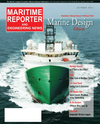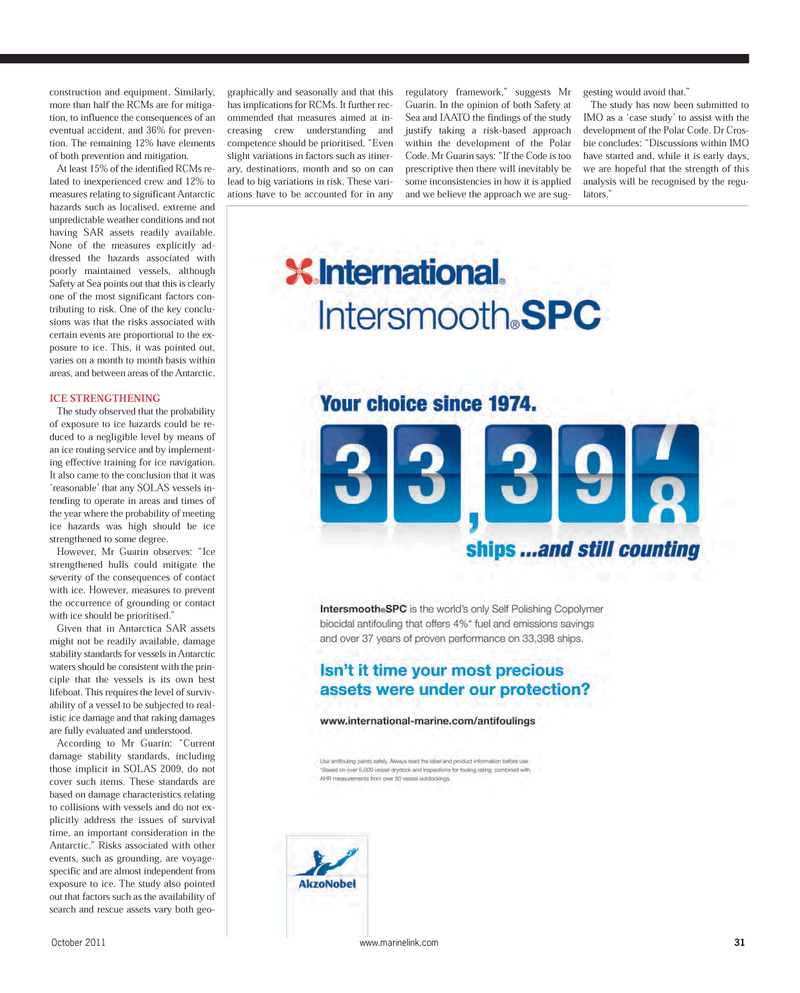
Page 31: of Maritime Reporter Magazine (October 2011)
Marine Design Annual
Read this page in Pdf, Flash or Html5 edition of October 2011 Maritime Reporter Magazine
October 2011www.marinelink.com 31construction and equipment. Similarly, more than half the RCMs are for mitiga- tion, to influence the consequences of aneventual accident, and 36% for preven- tion. The remaining 12% have elements of both prevention and mitigation. At least 15% of the identified RCMs re- lated to inexperienced crew and 12% to measures relating to significant Antarctic hazards such as localised, extreme and unpredictable weather conditions and nothaving SAR assets readily available. None of the measures explicitly ad- dressed the hazards associated withpoorly maintained vessels, although Safety at Sea points out that this is clearlyone of the most significant factors con- tributing to risk. One of the key conclu- sions was that the risks associated with certain events are proportional to the ex- posure to ice. This, it was pointed out, varies on a month to month basis within areas, and between areas of the Antarctic. ICE STRENGTHENINGThe study observed that the probability of exposure to ice hazards could be re- duced to a negligible level by means of an ice routing service and by implement-ing effective training for ice navigation. It also came to the conclusion that it was ?reasonable? that any SOLAS vessels in- tending to operate in areas and times ofthe year where the probability of meetingice hazards was high should be ice strengthened to some degree. However, Mr Guarin observes: ?Ice strengthened hulls could mitigate the severity of the consequences of contact with ice. However, measures to prevent the occurrence of grounding or contactwith ice should be prioritised.? Given that in Antarctica SAR assets might not be readily available, damage stability standards for vessels in Antarctic waters should be consistent with the prin- ciple that the vessels is its own best lifeboat. This requires the level of surviv- ability of a vessel to be subjected to real- istic ice damage and that raking damagesare fully evaluated and understood. According to Mr Guarin: ?Currentdamage stability standards, includingthose implicit in SOLAS 2009, do notcover such items. These standards are based on damage characteristics relatingto collisions with vessels and do not ex- plicitly address the issues of survival time, an important consideration in theAntarctic.? Risks associated with other events, such as grounding, are voyage- specific and are almost independent from exposure to ice. The study also pointed out that factors such as the availability of search and rescue assets vary both geo- graphically and seasonally and that thishas implications for RCMs. It further rec-ommended that measures aimed at in-creasing crew understanding and competence should be prioritised. ?Even slight variations in factors such as itiner- ary, destinations, month and so on can lead to big variations in risk. These vari- ations have to be accounted for in any regulatory framework,? suggests Mr Guarin. In the opinion of both Safety atSea and IAATO the findings of the study justify taking a risk-based approachwithin the development of the Polar Code. Mr Guarin says: ?If the Code is tooprescriptive then there will inevitably be some inconsistencies in how it is applied and we believe the approach we are sug- gesting would avoid that.? The study has now been submitted to IMO as a ?case study? to assist with the development of the Polar Code. Dr Cros- bie concludes: ?Discussions within IMOhave started and, while it is early days, we are hopeful that the strength of thisanalysis will be recognised by the regu- lators.? MR Oct.11 # 4 (25-33):MR Template 10/6/2011 4:22 PM Page 31

 30
30

 32
32
